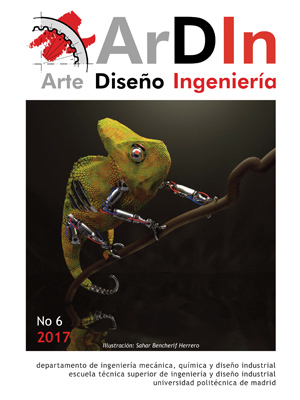Grabado no tóxico. Las fotos fotosensibles. Nuevas técnicas artísticas en el aula universitaria = Non-toxic gravure. Photogravure. New artistic techniques at university classrooms.
DOI:
https://doi.org/10.20868/ardin.2017.6.3589Keywords:
Planchas fotosensibles, Fotograbado, Grabado no tóxico, Transferencia multiplicidad imágenes, Proceso experiencia aula universitaria, Photosensitive plates, Photogravure, Non-toxic gravure, Transfer multiplicity images, Process experience university classAbstract
Resumen
Este artículo pretende hacer un recorrido breve por los antecedentes del fotograbado y los nuevos materiales que se utilizan actualmente en esta técnica. Recoge la experiencia de trabajar durante años con el fotograbado en talleres privados y aulas universitarias con materiales no tóxicos.
Muestra el fotograbado como parte del amplio abanico del que dispone el artista del S. XXI para sus creaciones multidisciplinares y como medio para transferir imágenes de una manera rápida, sin químicos, no solo en el ámbito de las artes gráficas, sino en combinación con todas las demás técnicas artísticas.
Abstract
This article aims to make a brief overview around the background of the photogravureand the new materials that are currently used in this technique. It gathersthe experience of working for years with photogravure in private workshopsand university classrooms with non-toxic materials.It reveals the photogravure as part of the wide range of techniques that the artists of the XXI century can use for their multidisciplinary creations and as a meanto transfer images quickly, without chemicals, not only in the field of graphic arts,but in combination with all the other artistic techniques.
Downloads
References
AA.VV. (1998). Estampa digital. La tecnología digital aplicada al arte gráfico. Catálogo de la exposición. Madrid: Calcografía Nacional. Real Academia de Bellas Artes de S. Fernando.
AA.VV. (1999). Huellas de luz. El arte y los experimentos de William Fox Talbot. Madrid: Museo Nacional Centro de Arte Reina Sofía. pp. 38-42
Alcalá, José R. y Pastor, Jesús (1997). Procedimientos de transferencia en la creación artística. Pontevedra: Diputación Provincial de Pontevedra. pp.34-37
Bellido, Ana. (2001). El grabado no tóxico en la escuela. Madrid: Edición de la Autora
Bridgeware, Peter; Woods, Gerard. (1993). Efectos en los fotograbados tramados. Barcelona: Gustavo Gili
Howard, Keith. (1991). Safe photo etching for photographers and artists. Canadá:Wynne Resources
Ivins, J. R. ; William, M. (1975). Imagen impresa y conocimiento: Análisis de la imagen prefotográfica. Barcelona: Gustavo Gili
Longley, Dianne. (1998). Printmaking with photopolymer plates. Adelaide, Australia: Ilumination Press
Pastor Bravo, Jesús (1989). Electrografía y grabado. Bilbao: Caja de ahorros Vizcaína.
WEBS
Moholy Nagy, László (2015) Moholy Nagy Foundation. Berlin. Recuperado de http://moholy-nagy.org/catalogue-raisonne/
Ganter, Jo (2017) .Gradations of light. Woodstock, NewYork, E.U. Wordpress. Recuperado de https://joganter.wordpress.com/
Caledonia, Curry (2016) Swoon. Nueva Orleans,.E.U :http://caledoniacurry.com/
Downloads
Published
Issue
Section
License
ArDIn does not charge authors for processing or publishing an article and provides immediate Open Access to its content. All content is available free to the user or their institution. Users are permitted to read, download, copy, distribute, print, search or link to the full text of articles, or use them for any other lawful purpose, without prior permission from the publisher or author. This is in accordance with the BOAI definition of open access.
- Authors retain the copyright and grant to the journal the right to a Creative Commons attribution / Non-Commercial / Non-Derivative 4.0 International (CC BY NC ND) License that allows others to share the work with an acknowledgement of authorship and non-commercial use.
- Authors may separately establish additional agreements for the non-exclusive distribution of the version of the work published in the journal (for example, placing it in an institutional repository or publishing it in a book).
Unless otherwise indicated, all contents of the electronic edition are distributed under a Creative Commons license.













